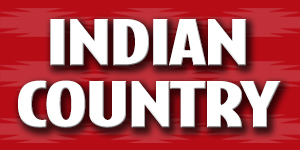Waapi Kani Cedar House hosts Winter Wellness Gathering

Daisy Hood speaks at the Winter Wellness Gathering on January 31.
By LORI ANN EDMO
Sho-Ban News
FORT HALL — In an effort to improve wellness in the community, the Waapi Kani Cedar House had a day-long Winter Wellness Gathering January 31 where participants heard storytelling, cultural teachings, did crafts, and visited information booths.
The day began with Lemuel Stone giving a prayer and Jason Butler, Behavioral Health manager doing a welcome.
Throughout the day crafts were taught at different information booths keeping youth participants occupied. There were 276 participants who attended.
Louise Dixey, Language and Culture Preservation Department manager, did a PowerPoint presentation on important cultural teachings — tenechuive in Bannock language and teniwap in Shoshone language. It’s the full body of cultural knowledge including language, dances, songs, along with oral teachings ceremonies, living, dying and caring for children.
She provided place names on the Fort Hall Reservation including Ross Fork District – Kaiva Tuhatte in Bannock, Lincoln Creek District – Moa Tevopuni Novi, Bannock Creek District – Pasakwa Huude, Fort Hall – Appetsi’Novi/Sai Novi and Gibson District – Sakwavi Kattede.
She displayed a map of tribal seasonal movement to acquire food sources in Oregon, Idaho, Montana, Wyoming, Nevada and Utah. She explained Native foods key to cultural survival include kana or bitterroot, pasigo or camas, teva or pine nuts, pakwi or pengwi – fish, agai or salmon, toishavui or chokecherries and yamba or wild carrots.
To show the nutrition value of eating one ounce of elk, she showed a nutrition label where it’s 27 calories with 5 calories from fat, it has one gram of fat, zero saturated or trans-fat, 14 milligrams of sodium, zero cholesterol, zero carbohydrate, six grams of protein and 11% iron. Deer (one ounce) is 44 calories with 18 from fat, two grams of fat, one-gram saturated fat, 22 milligrams cholesterol, 21 milligrams sodium, zero carbohydrate, zero sugars or dietary fiber, six grams of protein and 5% iron.
Dixey said teviwa or tebiwa is the Bannock term for land or inhabited across a large territory utilizing a wide range of resources. “Yet, although a given group could range hundreds of miles each year, it also occupied a traditional “Native land” (tebewa in Bannock, deviwa in the Shoshone dialect. Here the group usually wintered and had uncontested access to resources,” she continued. Mongoni or waippe is the Bannock and Shoshone terms for women. There is no separation between Newenee and the land we walk on – we are one with Mother Earth. Tribal communities suffer severely when our most valuable resources – our people and our land are exploited. “Tribal teachings explain our roles – young and old alike have a responsibility to learn, share, teach.”
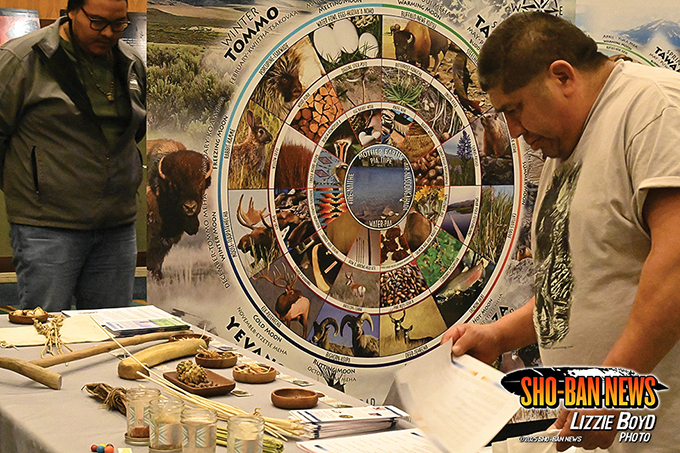
TJ Eschief visits Language & Culture Preservation Department's informational booth.
Dixey said Shoshone and Bannock languages must be preserved if we are to survive as a distinct, unique tribe. The unique songs and dances of our people must also be preserved – Sundance songs, Warm Dance, Ghost dance and 49 songs sung by Shoshone and Bannock singers are unique to this tribe. Songs must be used for the purpose intended not for commercial or personal gain. Annually the Tribes Culture Committee schedules gatherings to our cultural territories.
She showed the original Fort Hall Reservation and what it is today. It was created by Executive Order in 1867 – the area defined was 1.8 million acres. The Fort Bridger Treaty was signed July 3, 1868. The Bannock Treaty mentioned in the Fort Bridger Treaty declared to be at Fort Hall by Executive Order. Later other bands were moved to Fort Hall. Wahatema’ doingende – Fort Hall Business Council – the Tribes adopted a Constitution and Bylaws pursuant to the Indian Reorganization Act of 1934 – it became effective in 1936. The governing body of the Tribe is the Fort Hall Business Council – the seven members are elected from the reservation at large. Members serve two-year staggered terms.
Dixey urged tribal members to record speakers, conduct oral interviews, take pictures, visit your homelands, educate our youth through language, songs, dances, stories and pictures. “Most importantly condition yourself to pray and converse in the language.”
Rose Ann Abrahamson told stories about fun and remembering values and teachings. The first one was about how coyote tricks his people, a story about Elko and about when skunk came to handgame. She utilized volunteers from the audience.
Nolan Brown and Bailey Dann from the LCPD Historic Research office explained the seasonal rounds calendar and had examples of traditional foods.
After lunch a panel of tribal elders spoke including Zelphia Towersap, Daisy Hood, Rose Ann Abrahamson, Nathan Small and Joan Tracy.
Towersap said she’s 91-years-old and still working. She teaches Shoshone and Bannock languages. She said we’re losing language, songs and deniwape, along with spirituality. She said the Bible is not our way or the white man’s church either. She said today we live in the white man’s ways and laws. She said unusual things are happening to our people and not many know how to fix it. She said the problem is people don’t talk to each other or don’t listen. She asked how many in the audience could speak the language. A few raised their hands. She said that’s good. She asked how many believed in the Native American Church and some did. She then asked about the Sundance and how many believed or the sweat and many raised their hands. We’ve made it to 2025 but where are we going? She asked where will we be in ten years – will there be land or water? She said we need to learn to protect ourselves.
Daisy Hood recalled her grandmother used to make baskets out of willow. She grew up in Bannock Creek but now lives in Fort Hall. She’s also lived in California and Oklahoma, but her heart’s always been in Bannock Creek. Her father was a Sundancer and had peyote meetings. He told her peyote is for healing and for those who go out to war to make sure they return safely and that was the two things she remembers. Back then they didn’t have electricity, had haul water and haul wood. Through the years she’s gained knowledge, when she went to school, one had to be a little bit better being a minority in a white world. She told her kids to remember they’re Native first and try to do better. She has three children that went to college. One son didn’t go to college but he’s doing well. She has nine grandkids and they’re doing well as they’ve all graduated from high school. Some graduated from college. She told them to not forget their traditions and she’s taught them Shoshone ways. Daisy said she learned how to do hides and even now she has two grandkids who can scrape, smoke and finish a hide. Both of her sons are into scraping and tanning hides.
Rose Ann Abrahamson reflected on growing up at Indian Camp in Salmon. She lived in a village, and no one talked taivo (English). Every Sunday all the people would gather, grandmothers would sit there, she would lean against, she heard prophecies, stories. Her grandmother gave a vision she had. Rose Ann was 8 years old at the time. Sixty-two years ago, she said we would be buying water, the people laughed. Today we are buying water. Second prophecy was we would be buying air and that freaked her out. She asked if she was talking about her Cpap machine. The third she spoke in Shoshone and told those present to find someone who can translate it. It was white men will lie to you.
She said she learned beautiful things from her grandmother. All in all, treat each other good. Be generous, help them. She presented Vera Snipe with a gift because she listens and she’s very kind. She said kindness is powerful and thanked her for being powerful. To be truly Indian, one has to be kind. It’s the first teaching loving, caring, giving, she said.
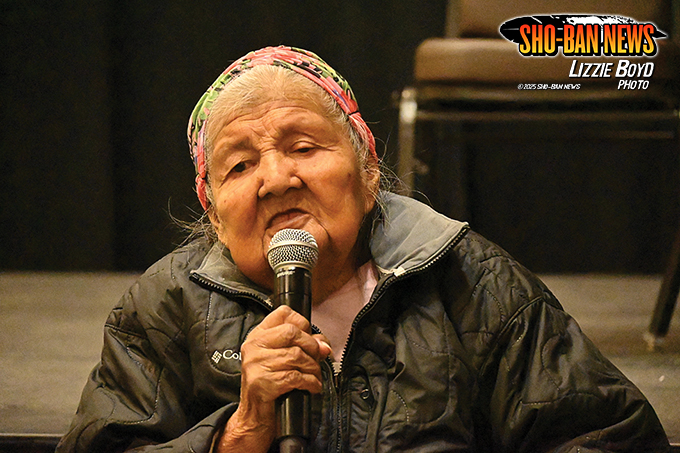
Sylvania Charles speaks at the Winter Wellness Gathering.
Rose Ann asked people to smile, smile big. She traveled with elders and noted other tribes and what they call themselves. She asked Walter Nevada and Lois Tyler what we called ourselves and they said we forgot. It’s wihinite and asked people to stand up if they’re proud. She did the same for those who are panakwate and asked them to stand if they’re proud. She was told by the elders, “Be strong, good, be kind, be sharing and think about each other.” And that’s who we are as Indigenous people – treat each other good.
Nathan Small remembered the days when he was young, his family would go to gatherings on the rez. There used to be rabbit drives – they would gather and hunt rabbits where Sands Road is now. They would also gather in the potato fields and wheat fields – it was sagebrush then there was no farmland. He recalled gathering at the districts when there would be war dances, they’d go over to dance and sing. In Ross Fork, they’d dance in the basement of the old school. Buffalo Lodge was the same – there would be big gatherings. Back then our people weren’t many maybe 2,500. Not many laws but we started to grow. When the laws changed, we started enrolling more people. He remembered the warm dances when at times one couldn’t get inside – you would have to stand outside and listen. Now you can get everybody inside, “so the gatherings we used to have are starting to slow down a little bit.” Small said at all those gatherings that we used to have it was always a good time. Before the coming of the white man, there was millions of us in the United States. He recalled a story told to him the camps used to be from the headwaters of Spring Creek clear down past American Falls, clear past that almost all the way to Shoshone Falls. That’s how big of a camp we had at one time.
Nathan said young kids used to play on Ferry Butte. The kids looked way out in the desert and seen a cloud coming their way like a V. They ran down and told everybody. An old lady told them to be careful, watch out for them. All the men got ready, got on their horses, got their stuff together so they were ready to protect the rest of the people. The men rode out that way chasing the bad people away. They didn’t know the bad people had disease and it just about killed everybody. People had to move away and get away from the disease. “So, when we gather, you got to be careful, we still got diseases here, we still got things out there that can kill us.”
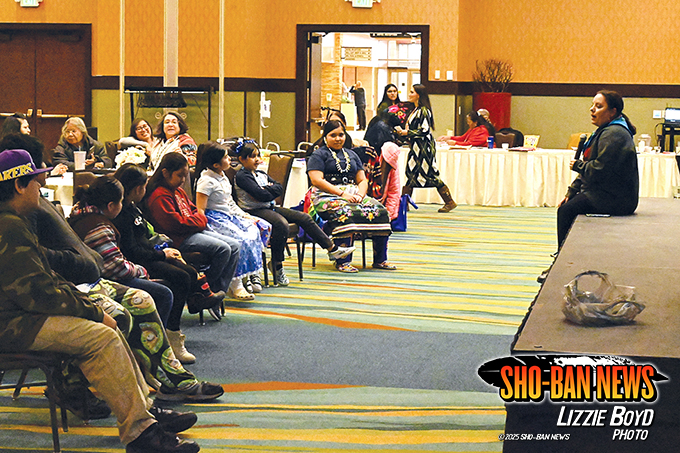
Bailey Dann asks questions of youth during the Knowledge Bowl.
He said the gatherings used to be in a good way, it was always about learning, “When we were kids we used to go war dancing with the older guys, we’d watch them. And we’d hear and see how they danced all the old ways – we learned a lot of that.” But it kind of went away for a while. He recalled the late Clyde Dixey telling him how the young people don’t know about the dances and it needed to be taught. So, Dixey started having classes at Eagle Lodge.
Nathan said there needs to be more teaching to bring the dances back, so it’s not lost again. There used to be social dances, and the district need to start doing those types of gatherings again, he said. He noted tribes are always having to defend themselves, defend our existence. “So, let’s not forget who we are. Let’s get back to what we used to be. And we’re not going to forget who we are – we’re going to get back to who we are,” he said.
Joan Tracy said her mother was Shoshone-Bannock and her father Navajo. It put stress on her to learn all the languages but she’s doing her best. She shared water is life, and she comes from a strong belief of Native American Church. She is a water carrier too. “We want to share good happy feelings, good thoughts, good resilience because that’s who we are as Native people. And I ask for forgiveness for my elders here for speaking before them, you know.” The teachings she’s learned is to be respectful of elders. “This water of life, what my mother told me, you know, in everyday life you struggle at times. You’re far away from any traditional reaching. Sometimes you will have cedar. Sometimes you will have tobacco. And the only thing you will have is water. You take a drink of it.” She said you can change your values, how you’re going about life. “Maybe you’re going the wrong way, misleading, misguiding yourself. But you can take this water of life like a reflection. A mirror image. You can look into this water. It can show your reflection in it. If you don’t like what you see, you can change it. You have the ability to change yourself within by thought, by mind, by heart, by action.”
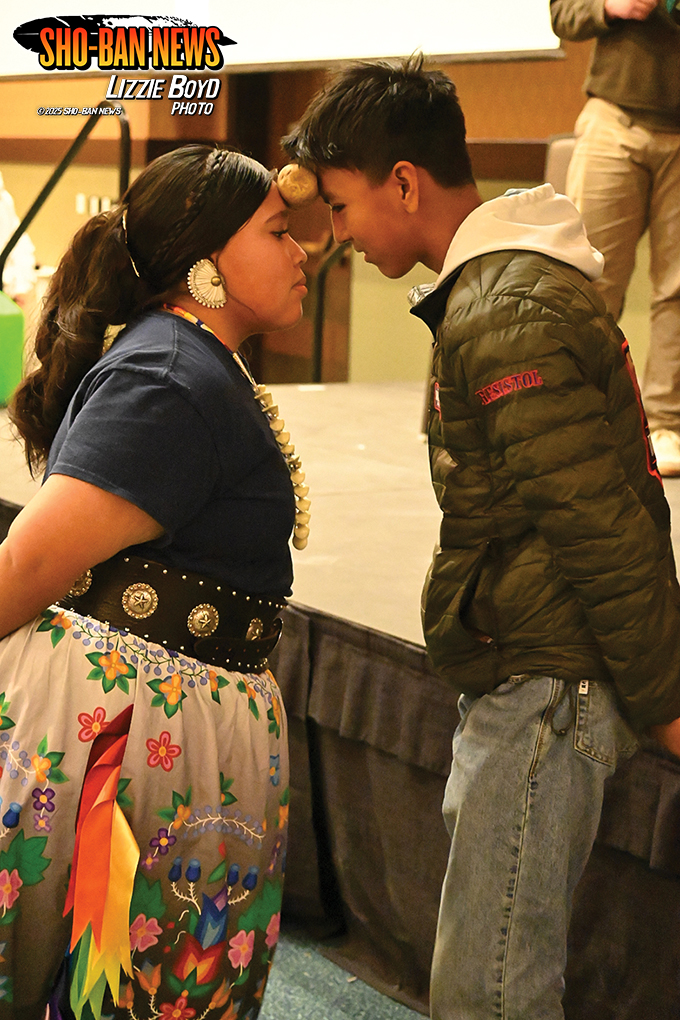
Potato dancers Susan Avila-Dixey and Gator Boyd.
After the panel, Bailey Dann conducted a knowledge bowl with the youth that were present asking various questions for them to answer including the year of the Fort Bridger Treaty, counting to ten in Shoshone and Bannock, among others.
After dinner, a hand drum contest was conducted where Spring Creek Singers consisting of Winston Bearing, Kylen Stump and Chasen Coby won first and $75. Sylvania Charles sang about spring water placing second earning $50 and Alonzo Picard was third receiving $25. A total of ten participants competed for cash prizes. A potato dance was the final event that Gator Boyd and Susan Avila Dixey won.




